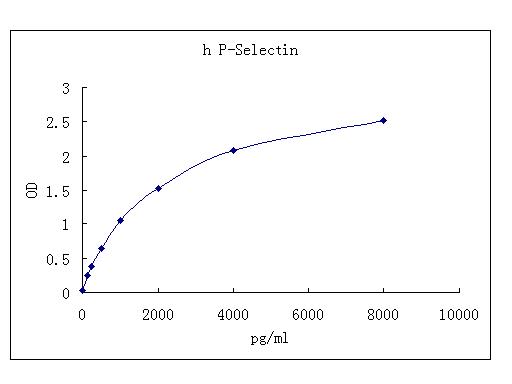Detect Range: 125-8000pg/ml
Sensitivity: 62pg/mL
Sample Type: Cell culture supernatant, serum, plasma (EDTA, citrate, heparin)
Sample Volume: 20 uL
Assay Time: 3 hours
Detection method: Colorimetric

P-Selectin (GMP-140, LECAM-3, PADGEM, CD62, CD62P) is a cell surface glycoprotein that plays a critical role in the migration of lymphocytes into tissues (1 - 5). It is found constitutively in a pre-formed state in the Weibel-Palade bodies of endothelial cells and in the alpha granules of platelets (4). This stored P-Selectin is mobilized to the cell surface within minutes in response to a variety of inflammatory or thrombogenic agents (4). The mobilized P-Selectin is apparently present on the cell surface for only a few minutes after which it is recycled to intracellular compartments (4). Additional evidence indicates that transcription of P-Selectin mRNA can be activated in the endothelium by treatment with inflammatory mediators (6). P-Selectin consists of an NH2-terminal lectin type C domain, an EGF-like domain, nine complement control domains, a transmembrane domain, and a short cytoplasmic domain (1,2). Mouse P-Selectin shows a similar organization of functional domains and an overall sequence identity of approximately 73% (5, 6). However, mouse P-Selectin contains only eight complement control domains, suggesting that the absolute number of these domains is not crucial for function (6). The molecular weight predicted from the cDNA for P-Selectin is approximately 86,000 (1, 2). The observed molecular weight on reducing SDS-PAGE,however, is approximately 140,000 (2).
Evidence indicates that P-Selectin is involved in the adhesion of myeloid cells, as well as B cells and a subset of T cells, to activated endothelium (4). P-Selectin is also involved in the adhesion of platelets to monocytes and neutrophils, playing a central role in neutrophil accumulation within thrombi (4). The adhesion of leukocytes and neutrophils to the endothelium is initiated by weak interactions that produce a characteristic
Pigott, R. and C. Power (1993) in The Adhesion Molecule Facts Book, pp. 132.
Barclay, A.N. et al. (1993) in The Leukocyte Antigen Facts Book, pp. 240.
Ley, K. and T.F. Tedder (1995) J. Immunol. 155:525.
Tedder, T.F. et al. (1995) FASEB J. 9:866.
Lasky, L. (1995) Annu. Rev. Biochem. 64:113.
Weller, A. et al. (1992) J. Biol. Chem. 267:15176.
Lasky, L.A. (1993) Current Biol. 3:680.
Sako, D. et al. (1993) Cell 75:1179.
Moore, K.L. et al. (1995) J. Cell Biol. 128:661.
Gearing, A.J.H. and W. Newman (1993) Immunol. Today 14:506.
Ishiwata, N. et al. (1994) J. Biol. Chem. 265:21381.
Takeda, I. et al. (1994) Allergy Immunol. 105:128.
Katayama, M. et al. (1993) Br. J. Haematol. 84:702.
Facer, C.A. and A. Theodoridou (1994) Microbiol. Immunol. 38:727.
Gruschwitz, M.S. et al. (1995) Arthritis Rheum. 38:184.
Ikeda, H. et al. (1994) Coron. Artery Dis. 5:515.
My Review
© 2017, AbSci All Rights Reserved. E-mail: info@abscitech.com
南京川博生物技术有限公司版权所有
苏B1-20150380 苏ICP备15009006号-1